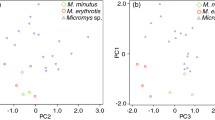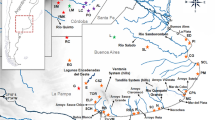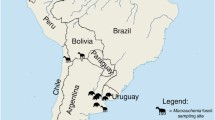Abstract
We examined temporal aspects of phylogenetic relationships among 5 murid rodent subfamilies and 11 arvicoline genera based on DNA sequences of the cytochrome b gene (n = 92) and ND4 gene (n = 17). We found monophyly for Muridae but a polytomy among murid subfamilies. Arvicolinae was monophyletic, but most genera within this subfamily arose from a polytomy. Microtus was monophyletic, but within the genus, species arose rapidly. This pattern of nested pulses (polytomies) was recovered across parsimony, distance, and likelihood methods and indicates that accumulation of taxonomic diversity in murids was sporadic, rather than gradual. Arvicolines appeared in the Late Miocene and diversified later, between 3 and 5 million years ago. A relatively high rate of sequence evolution (i.e., 2.3% in third-position transversions per million years) helps reconcile the diversification of fossils and mtDNA lineages.
Similar content being viewed by others
LITERATURE CITED
Alston, E. R. (1876). On the classification of the Order Glires. Proc. Zool. Soc. London 1876: 61–98.
Anderson, S. (1974). Patterns of faunal evolution. Q. Rev. Biol. 49: 311–332.
Arévalo, E., Davis, S. K., and Sites, J. W., Jr. (1994). Mitochondrial DNA sequence divergence and phylogenetic relationships among eight chromosome races of the Sceloporus grammicus complex (Phrynosomatidae) in central Mexico. Syst. Biol. 43: 387–418.
Bailey, V. (1990). Revision of the American voles of the genus Microtus. North Am. Fauna 17: 1–88.
Baker, R. J., Van Den Bussche, R. A., Wright, A. J., Wiggins, L. E., Hamilton, M. J., Reat, E. P., Smith, M. H., Lomakin, M. D., and Chesser, R. K. (1996). High levels of genetic change in rodents of Chernobyl. Nature 380: 801–802.
Barnosky, A. D. (1987). Punctuated equilibrium and phyletic gradualism. In: Current Mammalogy, Vol. 1, H. H. Genoways, ed., pp. 109–147, Plenum Press, New York.
Bennett, K. D. (1990). Milankovitch cycles and their effects on species in ecological and evolutionary time. Paleobiology 16: 11–21.
Bibb, M. J., Van Etten, R. A., Wright, C. T., Walberg, N. W., and Clayton, D. A. (1981). Sequence and gene organization of mouse mitochondrial DNA. Cell 26: 167–180.
Bremer, K. (1988). The limits of amino acid sequence data in angiosperm phylogenetic reconstruction. Evolution 42: 795–803.
Carleton, M. D. (1985). Macroanatomy. In: Biology of New World Microtus, R. H. Tamarin, ed., pp. 116–175, Special Publication, American Society of Mammalogists.
Carleton, M. D., and Musser, G. G. (1984). Muroid rodents. In: Order and Families of Recent Mammals of the World, S. Anderson and J. K. Jones, Jr., eds., pp. 289–379, John Wiley & Sons, New York.
Catzeflis, F. M., Nevo, E., Ahlquist, J. E., and Sibley, C. G. (1989). Relationships of the chromosomal species in the Eurasian mole rats of the Spalax ehrenbergi group as determined by DNA-DNA hybridization, and an estimate of the spalacid-murid divergence time. J. Mol. Evol. 29: 223–232.
Catzeflis, F. M., Aguilar, J.-P., and Jaeger, J.-J. (1992). Muroid rodents: Phylogeny and evolution. TREE 7: 122–126.
Catzeflis, F. M., Hänni, C., Sourrouille, P., and Douzery, E. (1995). Re: Molecular systematics of hystricognath rodents: The contribution of sciurognath mitochondrial 12S rRNA sequences. Mol. Phyl. Evol. 4: 357–360.
Chaline, J. (1987). Arvicolid data (Arvicolidae, Rodentia) and evolutionary concepts. In: Evolutionary Biology, Vol. 21, M. K. Hecht, B. Wallace, and G. T. Prance, eds., pp. 237–310, Plenum Press, New York.
Chaline, J. (1990). An approach to studies of fossil arvicolids. In: International Symposium on Evolutionary Phylogenetics and Biostratigraphy of Arvicolids, O. Fejfar and W. Heinrich, eds., pp. 45–84, Pfeil-Verlag, Prague.
Chaline, J., and Graf, J.-D. (1988). Phylogeny of the Arvicolidae (Rodentia): Biochemical and paleontological evidence. J. Mammal. 69: 22–33.
Chaline, J., Laurin, B., Brunet-Lecomte, P., and Viriot, L. (1993). Morphological trends and rates of evolution in arvicolids (Arvicolidae, Rodentia): Towards a punctuated equilibrium/disequlibrium model. Quaternary Int. 19: 27–39.
Chippendale, P. T., and Weins, J. J. (1994). Weighting, partitioning, and combining characters in phylogenetic analysis. Syst. Biol. 43: 278–287.
Conroy, C. J., and Cook, J. A. (1999). Molecular systematics of a holarctic rodent (Microtus: Muridae). J. Mammal. (in press).
Cooper, A., and Fortey, R. (1998). Evolutionary explosions and the phylogenetic fuse. TREE 13: 151–156.
Courant, F., David, B., Laurin, B., and Chaline, J. (1997). Quantification of cranial convergences in arvicolids (Rodentia). Biol. J. Linn. Soc. 62: 505–517.
DeBry, R. W. (1992). Biogeography of New World taiga-dwelling Microtus (Mammalia: Arvicolidae): A hypothesis test that accounts for phylogenetic uncertainty. Evolution 46: 1347–1357.
Engel, S. R., Hogan, K. M., Taylor, J. F., and Davis, S. K. (1998). Molecular systematics and paleobiogeography of the South American sigmodontine rodents. Mol. Biol. Evol. 15: 35–49.
Felsenstein, J. (1993). PHYLIP (Phylogeny Inference Package), Version 3.57c, University of Washington, Seattle.
Flynn, L. J., Jacobs, L. L., and Lindsay, E. H. (1985). Problems in muroid phylogeny: Relationship to other rodents and origin of major groups. In: Evolutionary Relationships Among Rodents: A Multidisciplinary Analysis, W. P. Luckett and J.-L. Hartenberger, eds., pp. 589–616, Plenum Press, New York.
Gilëva, E. A., Rybnikov, D. E., and Miroshnichenko, G. P. (1990). DNA-DNA hybridization and phylogenetic relationships in two genera of voles, Alticola and Clethrionomys (Microtinae: Rodentia). Doklady Nauk SSSR 311: 477–480.
Givnish, T. J., and Sytsma, K. J. (eds.) (1997). Molecular Evolution and Adaptive Radiation, Cambridge University Press, Cambridge and New York.
Gromov, I. M., and Polyakov, I. Ya. (1977). Fauna SSSR, Mlekopitayushchie, tom 3, vyp. 8 [Fauna of the USSR, Vol. 3, Part 8. Mammals]. Polevki [Voles (Microtinae)]. Nauka, Moscow-Leningrad. (English translation, Smithsonian Institution, Washington, DC.)
Hillis, D. M., and Huelsenbeck, J. P. (1992). Signal, noise, and reliability in molecular phylogenetic analyses. J. Hered. 83: 189–195.
Hillis, D. M., Moritz, C., and Mable, B. K. (1996). Applications of molecular systematics. In: Molecular Systematis, 2nd ed., D. M. Hillis, C. Moritz, and B. K. Mable, eds., pp. pp. 515–544, Sinauer Associates, Sunderland, MA.
Hinton, M. A. C. (1926). Monograph of the Voles and Lemmings (Microtinae) Living and Extinct, Vol. 1, Trust. Br. Mus., London.
Hoffmann, R. S. and Koeppl, J. W. (1985). Zoogeography. In: Biology of New World Microtus, R. H. Tamarin, ed., pp. 84–115, Special Publication, American Society of Mammalogists.
Hooper, E. T., and Hart, B. S. (1962). A synopsis of Recent North American microtine rodents. Misc. Publ. Mus. Zool. Univ. Mich. 120: 1–68.
Huelsenbeck, J. P., Swofford, D. L., Cunningham, C. W., Bull, J. J., and Waddell, P. J. (1994). Is character weighting a panacea for the problem of data heterogeneity in phylogenetic analysis? Syst. Biol. 43: 288–291.
Huston, M. A. (1995). Biological Diversity: The Coexistence of Species on Changing Landscapes, Cambridge University Press, Cambridge.
Irwin, D. M., Kocher, T. D., and Wilson, A. C. (1991). Evolution of the cytochrome b gene of mammals. J. Mol. Evol. 32: 128–144.
Jarrell, G. H., and Fredga, K. (1993). How many kinds of lemmings? In: The Biology of Lemmings, pp. 45–57, Linnean Society of London, London.
Jermiin, L. S., Graur, D., Lowe, R. M., and Crozier, R. H. (1994). Analysis of directional mutation pressure and nucleotide content in mitochondrial cytochrome b genes. J. Mol. Evol. 39: 160–173.
Kimura, M. (1980). A simple method for estimating evolutionary rates of base substitutions through comparative study of nucleotide sequences. J. Mol. Evol. 16: 111–120.
Kishino, H., and Hasegawa, M. (1989). Evaluation of the maximum likelihood estimate of the evolutionary tree topologies from DNA sequence data, and the branching order in Hominoidea. J. Mol. Evol. 29: 170–179.
Kitching, I. J. (1994). The determination of character polarity. In: Cladistics: A Practical Course in Systematics, P. L. Forey, C. J. Humphries, I. J. Kitching, R. W. Scotland, D. J. Siebert, and D. M. Williams, eds., pp. 22–43, Oxford Science, Systematics Association Publication No. 10, Oxford.
Klicka, J., and Zink, R. M. (1997). The importance of recent ice ages in speciation: A failed paradigm. Science 277: 1666–1669.
Kraus, F., and Miyamoto, M. M. (1991). Rapid cladogenesis among the pecoran ruminants: evidence from mitochondrial DNA sequences. Syst. Zool. 40: 117–130.
Kumar, S., Tamura, K., and Nei, M. (1993). MEGA: Molecular Evolutionary Genetics Analysis, Version 1.02, Pennsylvania State University, University Park.
Lara, M. C., Patton, J. L., and Da Silva, M. N. F. (1996). The simultaneous diversification of South American echimyid rodents (Hystricognathi) based on complete cytochrome b sequences. Mol. Phyl. Evol. 5: 403–413.
Lessa, E. P., and Cook, J. A. (1998). The molecular phylogenetics of tuco-tucos (genus Ctenomys, Rodentia: Octodontidae) suggests an early burst of speciation. Mol. Phyl. Evol. 9: 88–99.
Maddison, D. R. (1991). The discovery and importance of multiple islands of most-parsimonious trees. Syst. Zool. 40: 315–328.
Maddison, W. P., and Maddison, D. R. (1992). MacClade 3.0: Interactive Analysis of Phylogeney and Character Evolution, Sinauer Associates, Sunderland, MA.
Martin, A. P., and Palumbi, S. R. (1993). Body size, metabolic rate, generation time and the molecular clock. Proc. Natl. Acad. Sci. USA 90: 4087–4091.
Martin, L. D. (1975). Microtine rodents from the Ogallala Pliocene of Nebraska and the early evolution of the Microtinae in North America. Univ. Mich. Pap. Paleontol. 12: 101–110.
Matthey, R. (1957). Cytolgie comparée, systématique et phylogénie des Microtinae (Rodentia-Muridae). Rev. Suisse Zool. 64: 39–71.
Medrano, J. F., Aasen, E., and Sparrow, L. (1990). DNA extraction from nucleated red blood cells. Biotechniques 8: 43.
Miller, G. S., Jr. (1896). The genera and subgenera of voles and lemmings. North Am. Fauna 12: 1–84.
Modi, W. S. (1987). Phylogenetic analyses of the chromosomal banding patterns among the Nearctic Arvicolidae. Syst. Zool. 36: 109–136.
Modi, W. S. (1996). Phylogenetic history of LINE-1 among arvicolid rodents. Mol. Biol. Evol. 13: 633–641.
Mooers, A. Ø., and Heard, S. B. (1997). Inferring evolutionary process from phylogenetic tree shape. Q. Rev. Biol. 72: 31–54.
Musser, G. G., and Carleton, M. D. (1993). Family Muridae. In: Mammal Species of the World: A Taxonomic and Geographic Reference, 2nd ed., D. E. Wilson and D. M. Reeder, eds., pp. 501–755, Smithsonian Institution Press, Washington, DC, and London.
Nadler, C. F., Zhurkevich, N. M., Hoffmann, R. S. Kozlovskii, A. I., Deutsch, L., and Nadler, C. F., Jr. (1978). Biochemical relationships of the Holarctic vole genera (Clethrionomys, Microtus, and Arvicola (Rodentia: Arvicolinae)). Can. J. Zool. 56: 1564–1575.
Naylor, G. J. P., and Brown, W. M. (1998). Amphioxus mitochondrial DNA, chordate phylogeny, and the limits of inference based on comparisons of sequences. Syst. Biol. 47: 61–76.
Nikoletopoulos, N. P., Chondropoulos, B. P., and Fraguedakis-Tsolis, S. E. (1992). Albumin evolution and phylogenetic relationships among Greek rodents of the families Arvicolidae and Muridae. J. Zool. Lond. 228: 445–453.
Novacek, M. J. (1992). Fossils, topologies, missing data, and the higher level phylogeny of eutherian mammals. Syst. Biol. 41: 58–73.
O'hUigin, C., and Li, W.-H. (1992). The molecular clock ticks regularly in muroid rodents and hamsters. J. Mol. Evol. 35: 377–384.
Patton, J. L., dos Reis, S. F., and da Silva, M. N. F. (1996). Relationships among didelphid marsupials based on sequence variation in the mitochondrial cytochrome b gene. J. Mammal. Evol. 3: 3–29.
Reig, O. A. (1989). Karyotypic repatternings as one triggering factor in cases of explosive speciation. In: Evolutionary Biology of Transient Unstable Populations, A. Fontdevila, ed., pp. 246–289, Springer-Verlag, Berlin.
Repenning, C. A. (1968). Mandibular musculature and the origin of the subfamily Arvicolinae (Rodentia). Acta Zool. Cracov 13: 29–72.
Repenning, C. A., Fejfar, O., and Heinrich, W.-D. (1990). Arvicolid rodent biochronology of the Northern Hemisphere. In: International Symposium on the Evolution and Phylogenetic Biostratigraphy of Arvicolids, O. Fejfar and W.-D. Heinrich, eds., pp. 385–418, Pfeil-Verlag, Prague.
Riddle, B. R. (1995). Molecular biogeography in the pocket mice (Perognathus and Chaetodipus) and grasshopper mice (Onychomys): The late Cenozoic development of a North American aridlands rodent guild. J. Mammal. 76: 283–301.
Robinson, M., Catzeflis, F., Briolay, J., and Mouchiroud, D. (1997). Molecular phylogeny of rodents, with special emphasis on murids: Evidence from nuclear gene LCAT. Mol. Phyl. Evol. 8: 423–434.
Ruedas, L. A., and Kirsch, J. A. W. (1997). Systematics of Maxomys Sody, 1936 (Rodentia: Muridae: Murinae): DNA/DNA hybridization studies of some Borneo-Javan species and allied Sundaic and Australo-Papuan genera. Biol. J. Linn. Soc. 61: 385–408.
Russo, C. A. M., Takezaki, N., and Nei, M. (1996). Efficiencies of different genes and different tree-building methods in recovering a known phylogeny. Mol. Biol. Evol. 13: 525–536.
Saiki, R. K., Gefland, D. H., Stoffel, S., Scharf, S. J., Higuchi, R., Horn, G. T., Mullis, K. B., and Erlich, H. A. (1988). Primer-directed enzymatic amplifications of DNA with thermostable DNA polymerase. Science 239: 487–491.
Saitou, N., and Nei, M. (1987). The neighbor-joining method: A new method for reconstructing phylogenetic trees. Mol. Biol. Evol. 4: 406–425.
Sanderson, M. J., and Donoghue, M. J. (1996). Reconstructing shifts in diversification rates on phylogenetic trees. TREE 11: 15–20.
Smith, M. F., and Patton, J. L. (1993). The diversification of South American murid rodents: Evidence from mitochondrial DNA sequence data for the akodontine tribe. Biol. J. Linn. Soc. 50: 149–177.
Sorenson, M. D. (1996). TreeRot, University of Michigan, Ann Arbor.
Springer, M. S. (1995). Molecular clocks and the incompleteness of the fossil record. J. Mol. Evol. 41: 531–538.
Stanley, S. M. (1979). Macroevolution: Pattern and Process, W. H. Freeman, San Francisco.
Swofford, D. L. (1997). PAUP*4.0d59: Phylogenetic Analysis Using Parsimony, distributed by the author.
Tajima, F. (1993). Simple methods for testing the molecular evolutionary clock hypothesis. Genetics 135: 599–607.
Tan, A.-M., and Wake, D. B. (1995). MtDNA phylogeography of the California newt, Taricha torosa (Caudata, Salamandridae). Mol. Phyl. Evol. 4: 383–394.
Vrba, E. S. (1993). Turnover-pulses, the Red Queen, and related topics. Am. J. Sci. 293-A: 418–452.
Vrba, E. S. (1995). On the connection between paleoclimate and evolution. In: Paleoclimate and Evolution, with Emphasis on Human Origins, E. S. Vrba, G. H. Denton, T. C. Partridge, and L. H. Burckle, eds., pp. 24–45, Yale University Press, New Haven, CT.
Wakeley, J. (1996). The excess of transitions among nucleotide substitutions: New methods of estimating transition bias underscore its significance. TREE 11: 158–163.
Wilson, D. E., and Reeder, D. M. (1993). Mammal Species of the World: A Taxonomic and Geographic Reference, 2nd ed., Smithsonian Institution Press, Washington, DC.
Wu, C.-I., and Li, W.-H. (1985). Evidence for higher rates of nucleotide substitutions in rodents than in man. Proc. Natl. Acad. Sci. USA 82: 1741–1745.
Zakrzewski, R. J. (1985). The fossil record. In: Biology of New World Microtus, R. H. Tamarin, ed., pp. 1–51, Special Publication No. 8, American Society of Mammalogists.
Zardoya, R., and Meyer, A. (1996). Phylogenetic performance of mitochondrial protein-coding genes in resolving relationships among vertebrates. Mol. Biol. Evol. 13: 933–942.
Author information
Authors and Affiliations
Rights and permissions
About this article
Cite this article
Conroy, C.J., Cook, J.A. MtDNA Evidence for Repeated Pulses of Speciation Within Arvicoline and Murid Rodents. Journal of Mammalian Evolution 6, 221–245 (1999). https://doi.org/10.1023/A:1020561623890
Issue Date:
DOI: https://doi.org/10.1023/A:1020561623890




